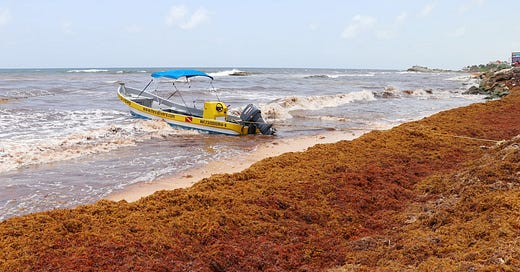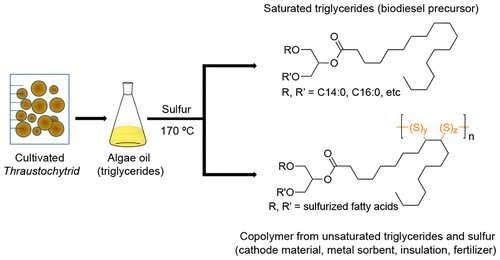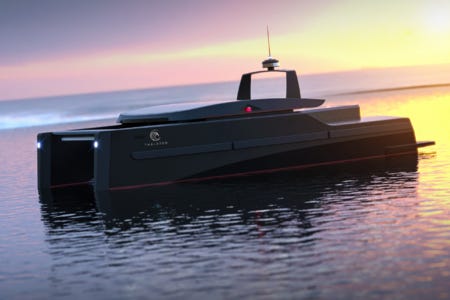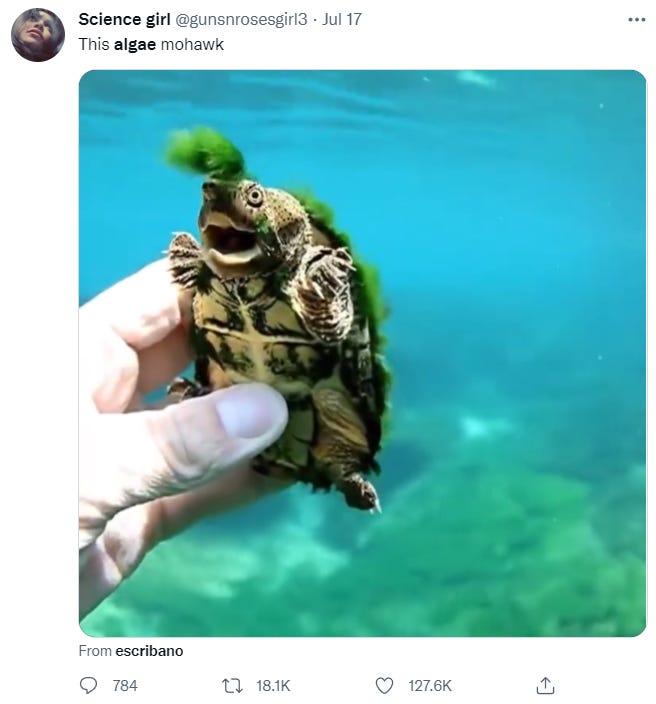🌿Meet the team saving the Caribbean from sargassum
PLUS Rumin8 receives $7 million in funding, Crùbag joins forces with SAMS, and “Mr Sargassum”
"Foster a multi-dimensional approach to problem solving. Many of these global challenges encompass social, environmental, and economic issues, so your solution should address all of these aspects." — Paulina Zanela
Dear algae technologists - hello and welcome to the Paxtier Report!
This week, researchers at Flinders University described an innovative, low-cost method to extract high-value bioactives from single-cell algae oil - using waste sulfur:
This sulfur reaction can draw up to 90% of unsaturated triglycerides from cultured single-cell algae, and here’s what Professor Justin Chalker had to say:
"The polyunsaturated triglycerides form polymers with many established uses, such as environmental remediation. Meanwhile, the saturated triglycerides remain unreacted in this process, where they can be recovered and converted into value-added substances such as biodiesel."
See more HERE.
In today’s report:
Markets: 🐄Rumin8 has received $7 million in investment
Deals: 🤝Crùbag has joined forces with SAMS
Research Rundown: 🧪Using seaweed on seaweed
💬 Movers and Shakers:🌿Meet the team saving the Caribbean from sargassum
Around the web: “Mr Sargassum” - the man building bricks out of algae.
Markets and Investing
✂️Algae Market Snippets
Some big moves this week included:
🐄West Australian climate technology company Rumin8 received $7 million in funding from domestic and international climate impact funds. Rumin8’s lead product claims to replicate the methane reductions of red seaweed (Asparagopsis), but instead of harvesting from the marine ecosystem, the plant’s “methane busting bioactive” is manufactured and transformed into a scalable, stable feed supplement in Rumin8’s quality-controlled laboratories. (Read more HERE.)
WNDR Alpine unveils its 108 Backcountry Ski, a product combining the brand’s AlgalTech® and SpiralMade™ materials. (Read more HERE).
Purissima announced a multi-year processing and distribution partnership with Open Book Extracts (OBX), a total solution provider for high quality cannabinoid ingredients. This makes Purissima the first company to achieve commercial scale production of minor cannabinoids using Purissima's proprietary algae-based fermentation platform. (Read more HERE).
Crùbag has joined forces with SAMS to explore the use of sustainable dyes from seaweed. Crùbag, an established business in ocean-inspired fashion, introduced its new research and development innovation project at the recent Sustainable Angle Future Fabrics Expo in London. (Read more HERE).
SeaGrown announced their new partnership with the Yorkshire Wildlife Trust to deliver a series of nature tourism and marine activities as part of the Wild Eye programme over the next 3 years. (Read more HERE).
Rimrock Gold Corp Announces Sale of Astound NMN to Branded Legacy, Inc. “The changes that we are making today are an important first step to refocus the our company priorities. Our aim is to become a leader in the algae farming sector, and increase value for the company and shareholders” said Jordan Starkman, CEO. (Read more HERE).
Pearlita Foods has successfully manufactured ‘the world's first alternative oyster prototype’. And this prototype consists of a proprietary mushroom and seaweed base. (Read more HERE)
Neptune Elements just announced its first €1M fundraise 🚀 🌊 Neptune Elements was created in 2021 by Cécile Bury and Victoire de Lapasse. The two founders have given themselves the double mission of democratising the consumption of seaweed in everyday life and developing the industry in France. (Read more HERE).
Canzon launch new organic CBD with algae cosmetic line (Read more HERE.)
The Seaweed Bath Co. undergoes an ocean-inspired rebrand, and lowers prices. The new look ushered in by agency Bex Brands is inspired by the magic of the sea, according to co-founder Allison Grossman. (Read more HERE).
In depth with Peter Green
🌿Meet the team saving the Caribbean from sargassum
Let’s be honest - sargassum has become a problem. In ‘normal years’, this brown seaweed forms large, open ocean floating mats and sometimes washes up on popular Caribbean beaches. But since 2011, blooms have been growing and the effects have been devastating: clogged beaches, crippled businesses, and dying coral reefs.
So, how can we solve this issue?
Meet Thalasso’s “Ocean Harvester” - an autonomous drone which the team can control from anywhere in the world:
As it skims the water’s surface, this device picks and packs sargassum mats. Then, after processing sufficient volumes of seaweed, it delivers the harvest to Thalasso's network of biorefineries. And it’s here, in these biorefineries, that the algae is transformed into various valuable bioproducts.
This week, I had the pleasure of speaking with Thalasso’s co-founders Frode Sønstebø and Paulina Zanela. And in this teaser, we discuss the evolution of the project, how countries can foster more ocean innovation, and advice for fellow algae tech entrepreneurs.
How has Thalasso evolved to where it is now?
Frode: “Paulina and I met in Panama while I was working in water treatment, and she was building a different start-up. During those early stages, we considered building a big ship to harvest pelagic seaweed. But we quickly realised how important open ocean sargassum is for the marine ecosystem. And that’s when we started focussing on smaller solutions, closer to shore.”
Paulina: “During my time on sargassum clearing vessels in Mexico, I noticed an overreliance on manual labour, and workers repeatedly spilling gasoline in the ocean.
That’s why we built our autonomous drone, which is an unmanned, electric seaweed harvester.
Where would you like to see more progress in the ocean tech space?
Frode: Naturally, I’d like to see more funding. While we have seen the rise of several climate-change leaders over the years, there are still very few risk-takers. We really need an influx of bigger professional investors who are willing to make some bets.
Paulina: From a Latin American/Caribbean perspective, I would love to see more cooperation. It’s very frustrating to see sargassum destroy beaches, coral reefs, and marine life. And it would be great to get more commitment at the government and federal level.
What advice would you give to others in this domain?
Frode: When it comes to building a business - be present, and talk to locals. Naturally, there’s a lot you can learn from a computer, but talking to people gives you a very different understanding.
I’d also recommend that you try to work together. These are big problems and there’s space for everyone. It’s great to see collaborations.
Paulina: I’d encourage folks to foster a multi-dimensional approach to problem solving. Many of these global challenges encompass social, environmental, and economic issues, so your solution should address all of these aspects. In this way, you can develop a broader, holistic solution.
If you’d like to learn more about Thalasso, be sure to check out their site, and you can follow Paulina and Frode on LinkedIn.
📝Research Rundown: Using seaweed on seaweed
THE BIG IDEA
So, now we’re on the subject of sargassum, let me direct your attention to Han et al.’s recent report, which explores the use of Sargassum horneri as a seaweed biostimulant.
The breakdown
Sargassum horneri is a major blooming algae endemic to Korea and China. Much like the Caribbean’s sargassum, this seaweed often forms large ocean mats which have a negative impact on aquaculture and tourism.
That’s why Han et al. want to utilise this biomass.
And that’s why this week, the team tested whether Sargassum horneri biostimulants can improve the growth and heat resistance of Neopyropia yezoensis, the most economically important seaweed species cultured in Korea.
Ultimately
Through a variety of extraction methods including boiling (SBE), soaking (SSE), autoclaving (SAE) and ethanol (SEE), the team collected several bioactive metabolites from the seaweed. And quite brilliantly, they discovered that SBE, SSE and SAE derived extracts did in fact increase Neopyropia yezoensis’s growth rate and tolerance to high-temperature stress.
And be sure to check out…
… This team’s detailed evaluation of extraction methods, which underscores the boiling process as the most suitable for developing seaweed biostimulants.
🔥 What else was hot in algae-tech this week?
(Paper) Cryopreservation of six Symbiodiniaceae genera and assessment of fatty acid profiles in response to increased salinity treatments. (Nature)
Solarvest BioEnergy Inc. adds Max Goldberg and Jerome Cliché to the advisory board. "What Eversea has developed -- the first certified organic omega-3 DHA from algae -- is truly groundbreaking. The majority of people do not fully understand the vital importance of omega-3 DHA, but when they do, they will look for it in the most pure, unadulterated form. And there is no higher quality form of omega-3 DHA in the world than what Eversea is offering. That is why I am so incredibly excited about this company's prospects and why I believe Eversea could be a dominant player in the supplement industry,"said Max Goldberg (Read more HERE)
From men’s seaweed bars to skincare and compostable pots: How Haeckels is revamping. Sustainable beauty brand Haeckels is undergoing a facelift following investment from Estée Lauder Companies. After years of difficulties, managing director Charlie Vickery outlines its path to profitability. (Read more HERE)
The Best Aquaculture Practices (BAP) Seaweed Farm Standard has been released for public comment, the Global Seafood Alliance (GSA) unveiled on July 14. The 60-day public comment period concludes on Sept. 13. (Read more HERE).
A team of Reliance Precision Apprentice Engineers, are headed to Farnborough Airshow 2022, for the final awards of the LaunchUK Nanosat Design Competition. One of five teams shortlisted for the final, Team NORI, have designed a satellite mission capable of measuring and monitoring the volume of marine biomass growing around the UK coastal waters. (See more HERE)
‘Inspiring to see’: scientists show how forests of kelp can potentially be brought back to life. Tasmania’s giant kelp has all but vanished, but worldwide restoration efforts provide hope the precious habitats can be rejuvenated. (Read more HERE).
Want to save the planet? Eat protein from mushrooms and algae instead of red meat: Jennifer O’Brien, founder of Sea and Believe, explains how childhood kelp baths not only restored her health but also helped to sow the seeds of this algae-based alt-seafood startup. (Read more HERE).
‘Mr. Sargassum’ has built 13 houses with blocks made from the smelly seaweed. A Quintana Roo man who invented a brick partially made out of sargassum has now built 13 “sargablock” homes for low-income families. (Read more HERE).
Introducing neutral tasting white Chlorella: ‘This enables application in formulations that previously weren’t possible. Aliga Microalgae is a Danish food tech company that has developed a white Chlorella ingredient that, it says, packs the nutritional punch of algae with a neutral taste and white colour. (Read more HERE).
Why Brevel says its microalgae will become the most popular alternative protein ingredient. (Read more HERE)
🐦Tweet of the week
That’s all folks!
Thanks again for joining us this week. Hope you have a great day and stay tuned for more algae tech updates soon!
Peter








